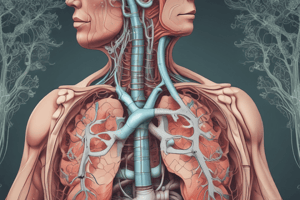Podcast
Questions and Answers
What does the expansion of lungs allow?
What does the expansion of lungs allow?
Influx of air
What does the contraction of the lungs force?
What does the contraction of the lungs force?
Outflow of air
How many lobes does the right lung have?
How many lobes does the right lung have?
3 lobes
How many lobules does the left lung have?
How many lobules does the left lung have?
What occupies the gap in the left lung?
What occupies the gap in the left lung?
What are the three main tissue components of the lungs?
What are the three main tissue components of the lungs?
What are bronchi?
What are bronchi?
What are alveoli?
What are alveoli?
What does vascular tissue do in the lungs?
What does vascular tissue do in the lungs?
What is the function of the trachea?
What is the function of the trachea?
What is the structure of the trachea?
What is the structure of the trachea?
How does the trachea obtain its flexibility?
How does the trachea obtain its flexibility?
Where is the trachea located?
Where is the trachea located?
What is the first division of the bronchi?
What is the first division of the bronchi?
How many divisions do the bronchial branches have on the left and right?
How many divisions do the bronchial branches have on the left and right?
Trachea and the first nine branches of the bronchi have _____________.
Trachea and the first nine branches of the bronchi have _____________.
The final 7 branches of the bronchi are called?
The final 7 branches of the bronchi are called?
What are terminal bronchioles?
What are terminal bronchioles?
What is the function of alveoli?
What is the function of alveoli?
What are capillary walls like?
What are capillary walls like?
What do pulmonary arteries do?
What do pulmonary arteries do?
What do pulmonary veins do?
What do pulmonary veins do?
What is the rate of blood flow of pulmonary arteries and veins?
What is the rate of blood flow of pulmonary arteries and veins?
What are bronchial arteries?
What are bronchial arteries?
What are pneumocytes?
What are pneumocytes?
What are type I pneumocytes?
What are type I pneumocytes?
What are type II pneumocytes?
What are type II pneumocytes?
Where is surfactant secreted?
Where is surfactant secreted?
Study Notes
Lung Mechanics
- Expansion of lungs decreases internal pressure, facilitating air inflow.
- Contraction of lungs increases pressure, resulting in air outflow.
Lung Structure
- Right lung: 3 lobes (superior, middle, inferior) and 3 lobules (upper, middle, lower).
- Left lung: 2 lobes (superior, inferior) with vestigial middle lobe (lingula).
- The left lung has a gap occupied by mediastinal structures (heart, esophagus).
Lung Composition
- Main tissue components: bronchi, alveoli, and vascular tissue.
- Bronchi: Tubes transporting gases to/from alveoli.
- Alveoli: Sites for air exchange, comprised of type I (gas exchange) and type II (surfactant production) pneumocytes.
- Vascular tissue: Carries blood to/from alveoli.
Trachea Function and Structure
- The trachea serves as a flexible windpipe, balancing rigidity for support and flexibility for movement.
- Composed of cartilaginous C-shaped rings, open posteriorly.
- Flexibility is provided by membranes between rings and smooth muscle that adjusts diameter.
Bronchial Tree
- Trachea branches into lobar bronchi entering lung lobes, further dividing into smaller branches.
- Left lung has 14 bronchial branches; right lung has 28.
- First nine bronchial divisions have cartilaginous rings for stability, while smaller branches lack these supports.
Respiratory Zones
- The last seven bronchi branches constitute the respiratory zones.
- Terminal bronchi are known as bronchioles; they end at alveolar ducts leading to alveoli.
Alveoli Structure
- Alveoli: Tiny sacs for gas exchange, numbering approximately 300 million in healthy lungs.
- Each alveolus is surrounded by about 2000 capillaries with extremely thin walls, facilitating rapid gas exchange.
Blood Supply to the Lungs
- Pulmonary arteries carry deoxygenated blood from the heart to alveoli.
- Pulmonary veins return oxygenated blood to the heart.
- Blood flow rate through pulmonary arteries and veins is 5000 mL per minute.
- Bronchial arteries provide an independent blood supply, transporting oxygenated blood to the lung tissue.
Pneumocyte Types
- Pneumocytes: Lung cells responsible for various functions.
- Type I pneumocytes: Thin, membranous cells vital for gas exchange, maximizing the surface area-to-volume ratio.
- Type II pneumocytes: Cuboidal cells that produce surfactant, significantly reducing surface tension and aiding alveoli expansion.
- Surfactant is secreted by type II pneumocytes, preventing surface tension from interfering with lung expansion.
Studying That Suits You
Use AI to generate personalized quizzes and flashcards to suit your learning preferences.
Description
Test your knowledge of the respiratory system with these flashcards focusing on lung mechanics and anatomy. Each card delves into concepts like lung pressure changes and lung lobes, essential for understanding respiratory function. Perfect for students in anatomy or physiology courses.




